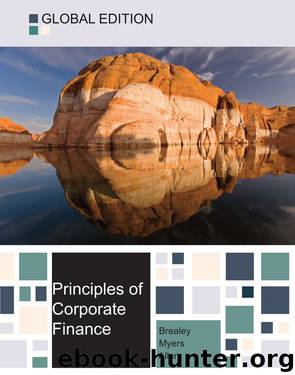Principles of Corporate Finance 11th Global Edition by Brealey

Author:Brealey
Language: eng
Format: epub
Tags: Principles of Corporate Finance
Published: 2013-06-20T00:00:00+00:00
Who gains and who loses from the following maneuvers?
a. Circular scrapes up $5 in cash and pays a cash dividend.
b. Circular halts operations, sells its fixed assets, and converts net working capital into $20 cash. Unfortunately the fixed assets fetch only $6 on the secondhand market. The $26 cash is invested in Treasury bills.
c. Circular encounters an acceptable investment opportunity, NPV = 0, requiring an investment of $10. The firm borrows to finance the project. The new debt has the same security, seniority, etc., as the old.
d. Suppose that the new project has NPV = +$2 and is financed by an issue of preferred stock.
e. The lenders agree to extend the maturity of their loan from one year to two in order to give Circular a chance to recover.
19. Agency costs The Salad Oil Storage (SOS) Company has financed a large part of its facilities with long-term debt. There is a significant risk of default, but the company is not on the ropes yet. Explain:
a. Why SOS stockholders could lose by investing in a positive-NPV project financed by an equity issue.
b. Why SOS stockholders could gain by investing in a negative-NPV project financed by cash.
c. Why SOS stockholders could gain from paying out a large cash dividend.
20. Covenants
a. Who benefits from the fine print in bond contracts when the firm gets into financial trouble? Give a one-sentence answer.
b. Who benefits from the fine print when the bonds are issued? Suppose the firm is offered the choice of issuing (i) a bond with standard restrictions on dividend payout, additional borrowing, etc., and (ii) a bond with minimal restrictions but a much higher interest rate? Suppose the interest rates on both (i) and (ii) are fair from the viewpoint of lenders. Which bond would you expect the firm to issue? Why?
21. Pecking-order theory “I was amazed to find that the announcement of a stock issue drives down the value of the issuing firm by 30%, on average, of the proceeds of the issue. That issue cost dwarfs the underwriter’s spread and the administrative costs of the issue. It makes common stock issues prohibitively expensive.”
a. You are contemplating a $100 million stock issue. On past evidence, you anticipate that announcement of this issue will drive down stock price by 3% and that the market value of your firm will fall by 30% of the amount to be raised. On the other hand, additional equity financing is required to fund an investment project that you believe has a positive NPV of $40 million. Should you proceed with the issue?
b. Is the fall in market value on announcement of a stock issue an issue cost in the same sense as an underwriter’s spread? Respond to the quote that begins this question.
Use your answer to (a) as a numerical example to explain your response to (b).
22. Exchange offers Ronald Masulis analyzed the stock price impact of exchange offers of debt for equity or vice versa.34 In an exchange offer, the firm offers to trade freshly issued securities for seasoned securities in the hands of investors.
Download
This site does not store any files on its server. We only index and link to content provided by other sites. Please contact the content providers to delete copyright contents if any and email us, we'll remove relevant links or contents immediately.
The Black Swan by Nassim Nicholas Taleb(6762)
Bad Blood by John Carreyrou(6274)
Pioneering Portfolio Management by David F. Swensen(6078)
Millionaire: The Philanderer, Gambler, and Duelist Who Invented Modern Finance by Janet Gleeson(4092)
Skin in the Game by Nassim Nicholas Taleb(3965)
The Money Culture by Michael Lewis(3846)
Bullshit Jobs by David Graeber(3826)
Skin in the Game: Hidden Asymmetries in Daily Life by Nassim Nicholas Taleb(3720)
The Wisdom of Finance by Mihir Desai(3523)
Blockchain Basics by Daniel Drescher(3327)
Liar's Poker by Michael Lewis(3220)
The Intelligent Investor by Benjamin Graham Jason Zweig(2930)
Hands-On Machine Learning for Algorithmic Trading by Stefan Jansen(2925)
Mastering Bitcoin: Programming the Open Blockchain by Andreas M. Antonopoulos(2891)
Fooled by Randomness: The Hidden Role of Chance in Life and in the Markets by Nassim Nicholas Taleb(2860)
Investing For Dummies by Eric Tyson(2791)
The Power of Broke by Daymond John(2770)
Market Wizards by Jack D. Schwager(2538)
Zero Hour by Harry S. Dent Jr. & Andrew Pancholi(2531)
